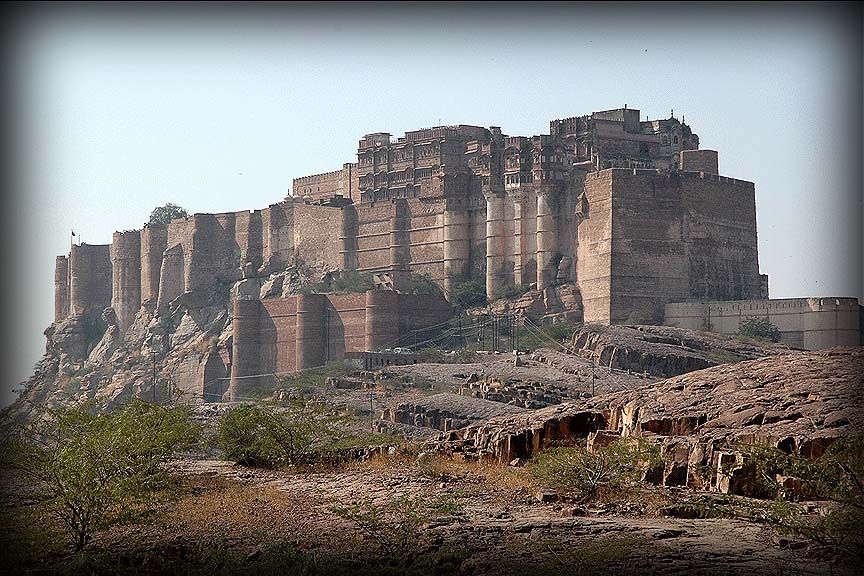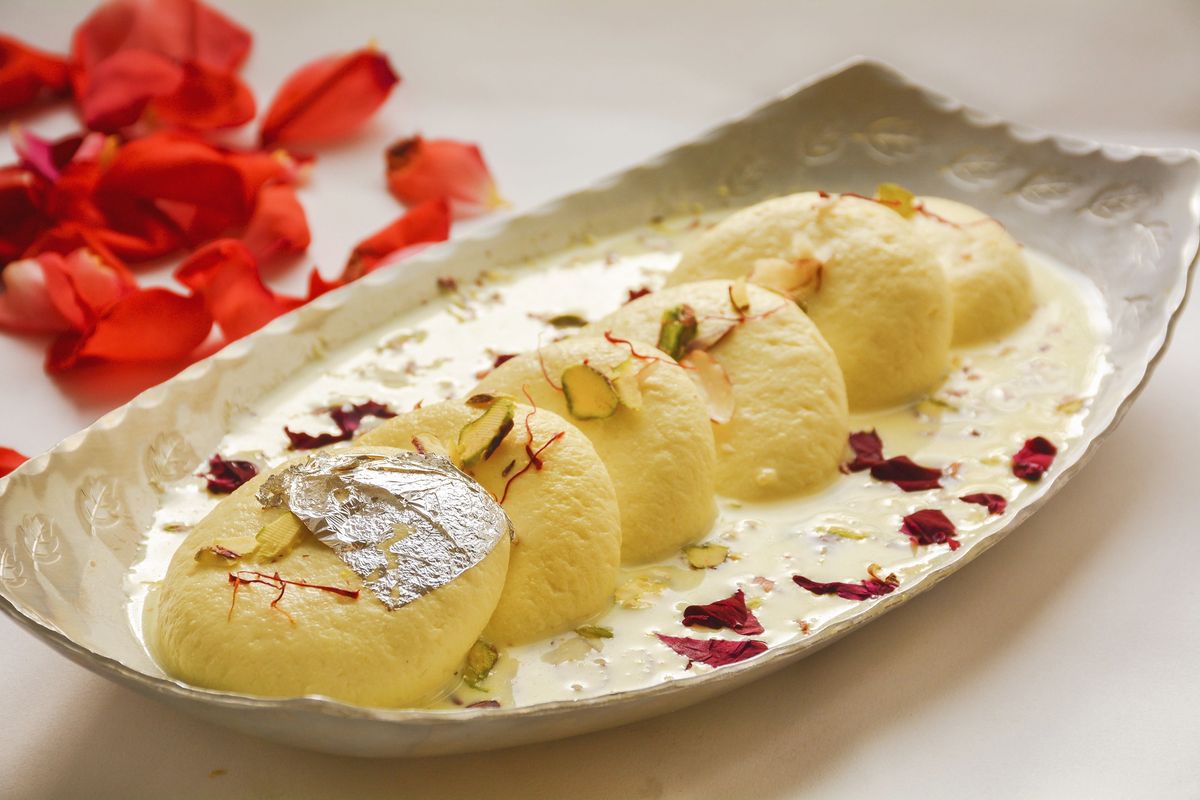INTRODUCTIONJodhpur is the second largest city in the Indian state of Rajasthan and officially the second metropolitan city of the state. It was formerly the seat of a princely state of the same name. The capital of the kingdom was known as Marwar. Jodhpur is a popular tourist destination, featuring many palaces, forts and temples, set in the stark landscape of the Thar Desert. The city is known as the "Sun City" for the bright and sunny weather it enjoys all the year round. The old city circles the fort and is bounded by a wall with several gates. Jodhpur is also known as the "Blue City" because of the blue colours that decorate many of the houses in the old city area. However, the city has expanded greatly outside the wall over the past several decades. Jodhpur lies near the geographic centre of the Rajasthan state, which makes it a convenient base for travel in a region much frequented by tourists.
official website of jodhpur
 Picture credits: jagdishartCUSINE Jodhpur Cuisine is synonymous to spice,
chilly, street food and a rich culture of sweets. There are a number of items
the city has on its menu which are brimming with color, festivity and spices.
One cannot come to Jodhpur and not try the almost staple and yet exciting in
every bite, Mirchi Bada, Mawa Kachori and Pyaaz Kachori.Almost as popular and a must try
item is Makhaniya Lassi.Jodhpur is an equal paradise for those who love
deserts- except that sweets will not just be the end of your course but are as
significant as the entire meal itself and have a vibrant food culture about
them. The popular indulges here are Besan
ki Chakki, Mave ki Kachori, Motichoor ke Laddu and Maakhan Vade.A number of dishes from Indian
cuisine originated in Jodhpur, such as Makhaniya Lassi, Mawa Ki
Kachori, Pyaaj Ki Kachori, Hot &
SpicyMirchi Bada, Dal Bati Churma, Lasan Ki Chutney, Mirchi Ka Kutaa, Gatte Ki Sabzi, Ker Sangri Sabzi, Raab, Lapsi, Aate Ka Halwa, Kachara Mircha Sabzi and Kadhi Pakoda with
Baajre Ka Sogra.
Picture credits: jagdishartCUSINE Jodhpur Cuisine is synonymous to spice,
chilly, street food and a rich culture of sweets. There are a number of items
the city has on its menu which are brimming with color, festivity and spices.
One cannot come to Jodhpur and not try the almost staple and yet exciting in
every bite, Mirchi Bada, Mawa Kachori and Pyaaz Kachori.Almost as popular and a must try
item is Makhaniya Lassi.Jodhpur is an equal paradise for those who love
deserts- except that sweets will not just be the end of your course but are as
significant as the entire meal itself and have a vibrant food culture about
them. The popular indulges here are Besan
ki Chakki, Mave ki Kachori, Motichoor ke Laddu and Maakhan Vade.A number of dishes from Indian
cuisine originated in Jodhpur, such as Makhaniya Lassi, Mawa Ki
Kachori, Pyaaj Ki Kachori, Hot &
SpicyMirchi Bada, Dal Bati Churma, Lasan Ki Chutney, Mirchi Ka Kutaa, Gatte Ki Sabzi, Ker Sangri Sabzi, Raab, Lapsi, Aate Ka Halwa, Kachara Mircha Sabzi and Kadhi Pakoda with
Baajre Ka Sogra.
picture credits: pankaj yadav
Jodhpur is known for its sweets
ranging from traditional "Makhanbada",
"Mawa Ki Kachori",
"Malpua",
"Ghevar",
"Motichur Ke Laddu",
"Besan barfi",
"Thorr" and "Gulab Jamun"
to Bengali "Rasgulla"
and "Ras Malai"
prepared by a traditional house "janta sweets"
HISTORY According
to the Rajasthan District Gazetteer's of Jodhpur and the Hindu epic Ramayana (composed
up to the 4th century AD),Abhiras were the original inhabitants of Jodhpur and
later Aryans spread to this region. There may have been small
settlements before Rathore rule. Aurangzeb briefly sequestrated the state (c.1679) on the pretext
of a minority, but the prior ruler Maharaja Ajit Singh was restored to the
throne by Veer Durgadas Rathore after Aurangzeb died in
1707 and a great struggle of 30 years. CLIMATE
The climate of Jodhpur is hot and semi-arid during its nearly yearlong dry season,
but contains a brief rainy season from late June to September. Although
the average rainfall is around 450 millimetres (18 in), it fluctuates
greatly. In the famine year of 1899, Jodhpur received only 24
millimetres (0.94 in), but in the flood year of 1917 it received as much
as 1,178 millimetres (46.4 in).Temperatures are extreme from March to
October, except when the monsoonal
rain produces thick clouds to lower it slightly. In the months of
April, May and June, high temperatures routinely exceed 40 degrees Celsius. During the monsoon season, average temperatures
decrease slightly. However, the city's generally low humidity rises, which adds
to the perception of the heat. The highest temperature recorded in Jodhpur was
on 18 May 2016 when it rose up to 53.2 degrees Celsius. TOURIST
PLACES Udai Mandir is an
architectural beauty. If you are an appreciator of architectural brilliance and
quality then this place is for you.Half of the temple entrance gate is made
from the carved sandstone (Jodhpur is the hub of sandstone).The main temple stands on a
huge raised platform and is supported by 102 pillars.Inside Udai Mandir there
are beautiful wall paintings with 84 Yogasanas and the pictures of Nath Yogis
made up with gold.The temple has a Garbh Griha.
The upper portion of the Garbh Griha is kept covered with cloth and is
surrounded by gold pots. The gold polishing in Udai Mandir still has its
original shine and quality.Siddhanth Shiv temple is
situated between Takhat Sagar hills and Kalyana Lake. Its way is on Chopasani
Road and it is about 10 Kms away from Jodhpur.You can reach the temple only
after crossing the hundreds of stairs made up by cutting rocks.Once upon a time
the place, exactly where the temple now stands, was completely a deserted area.Siddhanth Shiv temple is
believed to be built by GauriShanker (also called Nepali Baba, his real name
was Veetragi Narain Swami) himself by cutting stones.He was a handicapped saint who
had only four fingers in each of his hand and foot. Siddhanth Shiv temple is
situated between Takhat Sagar hills and Kalyana Lake. Its way is on Chopasani
Road and it is about 10 Kms away from Jodhpur.You
can reach the temple only after crossing the hundreds of stairs made up by
cutting rocks.Once upon a time the place,
exactly where the temple now stands, was completely a deserted area.Siddhanth Shiv temple is
believed to be built by GauriShanker (also called Nepali Baba, his real name
was Veetragi Narain Swami) himself by cutting stones.He was a handicapped saint
who had only four fingers in each of his hand and foot.Umaid Bhawan Palace is one of
the world’s largest private residences. Taj Hotels manage a part of the palace.It was named
after Maharaja Umaid Singh, grandfather of the present Maharaja Gaj Singh
II, this monument has 347 rooms and serves as the principal residence of the Jodhpur royal
family.A part of the palace has now
been converted into a hotel and a museum.Ghanta Ghar also known as
the clock tower.Beside the tower, there in the
Sardar Market that is trusted by tourists for shopping.From this market, you can
purchase Rajasthani textiles, clay articles, miniature camels and elephants,
marble inlay work and classic silver and gold jewelry.Om Banna Temple (also
known Om Bana, Bullet Banna and Bullet baba Temple) is a temple
located in Pali district near Jodhpur. It is located 20 Kms
from Pali and 50 Kms. The motorcycle is a 350cc Royal Enfield
Bullet.Om Bana, a local citizen, was
riding the bike, it got unbalanced and hit the tree. He was dead immediately.Police took motorcycle in the
police station but next day bike was found under the same tree. Even after
numerous attempts to take bike away, bike was found at the same place under the
tree where the accident happened.Santoshi Mata TempleLord Ganesha is the father of
Santoshi Mata.In Jodhpur there is a very old
and famous lake, which is surrounded by mountains and is named as Lal Sagar
Lake.Here is a natural ancient
temple of Santoshi Mata fulfilling the desires of all.This temple is surrounded by
various kinds of trees. In India, this is world class age old natural shrine,
which has amazing specialty.The mountain is elevated on
santoshi Mata temple as if Sheshnag (a kind of snake) is giving its shadow to
Mateshwari. There is an Amrit Kunda close to temple where an old tree is
in the same shape from many years. Near that tree there is very lovely
waterfall.Sardar Market is a full of
busy Indian market containing riots of sight and sound. The clock tower in the
center of Sardar Market is a useful reference point You can spend hours in shops
chatting with friendly owners who will offer a cup of masala chai (tea). This
is the true highlight of Rajasthani hospitality.You will find Jodhpur to be
full of amiable and kind people who will be quick to offer you chai (tea) as a
symbol of genuine hospitality first and foremost (not at all an attempt to
coerce you to buy).It is not uncommon for them to
turn their shop upside down to show you all of their goods and many are quite
proud of their businesses.FESTIVALS Jodhpur fairs and festivals seem to
express the rich culture and traditions Rajasthan. A number of festivals are
celebrated in Jodhpur. However the most famous Fairs and festivals in Jodhpur,
Rajasthan are:·
Marwar Festival
 tag on profile.
tag on profile.



